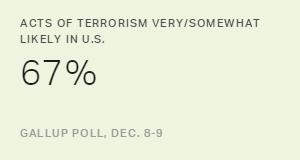Story Highlights
- More name big government as threat than big business, big labor
- Percentage naming government as threat down from record high in 2013
- Republicans still more likely than Democrats to say government is threat
WASHINGTON, D.C. -- When asked to choose among big government, big labor and big business, Americans overwhelmingly name big government as the biggest threat to the country in the future. The 69% choosing big government is down slightly from a high of 72% in 2013, the last time Gallup asked the question, but is still one of the highest percentages choosing big government in Gallup's 50-year trend.

While Americans have always seen big government as a bigger threat than big business or big labor, the percentage naming it was significantly lower prior to 1990, when a much larger segment of Americans saw big labor as the greatest threat. By 2000, the percentage naming big government rose to 65%, as mentions of big labor fell into the single digits. A brief uptick in concerns about big business in 2002, probably prompted by several high-profile business scandals such as Enron, offset some concerns about big government. More recently, concerns about business and labor have drifted down while concerns about big government have climbed back up to nearly 70%.
The large increase in the percentage naming big government as the biggest threat in 2013 may have resulted from the rollout of the Affordable Care Act and Edward Snowden's revelations about government monitoring of communications.
Republicans Remain Most Likely to Say Government Poses the Biggest Threat
Almost nine in 10 Republicans, 88%, say big government is the biggest threat to the future of the country, far exceeding the 67% of independents and 53% of Democrats who say the same. Since 1985, Republicans have been more likely than Democrats and independents to name big government as the biggest threat. One notable exception occurred in 2005, when mentions of big government were tied across the three groups. This may have been due to U.S. involvement in a prolonged war in Iraq, as well as the Bush administration's struggle to respond adequately to Hurricane Katrina.

While a majority of Democrats say that big government poses the biggest threat, many more Democrats (41%) than independents (25%) or Republicans (7%) say big business is the biggest threat.
Bottom Line
While down slightly from 2013, 69% of Americans say big government is the biggest threat to the country in the future. This comes at a time when Americans name the government as one of the three most important problems facing the country and when 75% of Americans perceive widespread corruption in the government.
Further, only 8% of Americans in June said they have "a great deal" or "quite a lot" of confidence in Congress, far below the 24% who said they have that much confidence in organized labor and 21% in big business. But slightly more Americans said they have confidence in the presidency and the Supreme Court than said they have confidence in organized labor or big business.
Half of Americans say the federal government poses an immediate threat to rights and freedoms, and Congress' job approval continues to languish -- perhaps explaining why so many see big government as the biggest threat to the country.
Historical data are available in Gallup Analytics.
Survey Methods
Results for this Gallup poll are based on telephone interviews conducted Dec. 2-6, 2015, on the Gallup U.S. Daily survey, with a random sample of 824 adults, aged 18 and older, living in all 50 U.S. states and the District of Columbia. For results based on the total sample of national adults, the margin of sampling error is ±4 percentage points at the 95% confidence level. All reported margins of sampling error include computed design effects for weighting.
Each sample of national adults includes a minimum quota of 60% cellphone respondents and 40% landline respondents, with additional minimum quotas by time zone within region. Landline and cellular telephone numbers are selected using random-digit-dial methods.
View complete question responses and trends.
Learn more about how the Gallup Poll Social Series works.


